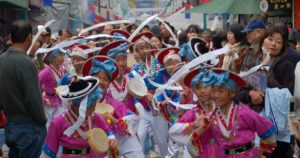What is Andon? Making Andon, a Japanese lantern
CONTENTS
Lantern making with a Japanese washi paper
The andon is a lantern made of Japanese paper and framed with bamboo or wood lit by burning oil or a candle. It is believed to be originally used by the Buddhist monks during the Muromachi period (1392-1573) as portable lighting. In the Edo period (1600-1867), the andon was especially popular for merchants to display lanterns with their shop’s names written on the paper covering. Even with modern andon that uses light bulbs, the soft light seeping through the paper gives off an ethereal beauty. Some traditional shops and restaurants still use andon outside to attract customers. Indoors, modern andon are popular as fashionable interior decoration in both Japanese and Western rooms.

Miyako Andon is a small family business that has been in operation for four generations. Located in the backstreets of Higashi Nippori, Tokyo, the building is new and surprisingly contemporary in design. A small garden separates the workshop area from the showroom. Takayuki Kizaki who leads the workshops is the fourth generation proprietor of Miyako Andon. He handles business with a casual yet professional flair. Kizaki explains that he holds workshops for the public to increase general knowledge and appreciation for the craft of Japanese style lighting. The small space accommodates only up to five participants at one time. This coziness leads to comradely and the experience of creating together is truly enjoyable.
Choosing the paper for your lantern is undoubtedly the most time-consuming and enjoyable part of the workshop. Miyako Andon provides an array of patterned and colored paper to select from. Some are exquisite work by famous washi artisan, but personal preference usually takes precedence over brand names. There is a lantern for you to hold your paper up against to see what it would look like when lit up because the lantern will look very different. Typically, lanterns with colored paper look nice when unlit but does not allow enough light through. Since all the papers are so interesting, there is a strong temptation to do a “patchwork” lantern using a different piece of washi for each side. Kizaki subtly encourages people to keep their creations simple. I fell in love with the lattice design right away and decided on having two sides and the top with the lace and two plain sides. The work of pasting the paper onto the wood is not particularly difficult. The lighting ceremony at the end is an exciting moment where everyone compliments each other’s work while secretly thinking their own is the most spectacular.
How to make a modern andon (Japanese lantern)

① The first thing to do at the workshop is to select the Japanese washi paper and decide on a design for your lantern.
② Then you begin to glue the paper onto the narrow ledges of each side of the wooden skeleton lantern frame. The lantern frame is pre-made from a kit and includes a light bulb.
③ The “glue” consists of two parts, special washi glue used for pasting shoji, Japanese traditional sliding doors, and normal white glue. The brush is small but it is important to put lots of glue because places without glue will bulge out when dried. The trick is to put more glue than you need, then wipe the ledge with the little towel you are given.

④ Miyako Andon has a special handcrafted wooden tool to swipe off excess glue while pressing the paper down onto the wood. The task is not difficult though it requires concentration. Using lacey patterned paper requires it to be reinforced first with a plain paper, so that side is covered twice.
⑤ Visitors are encouraged to go into the adjacent showroom while the glue dries. The showroom highlights Miyako Andon’s professional work. Some lanterns show off fine workmanship with twisted pieces of the wooden frame. Others highlight painstaking detailed craftsmanship. A few designs are objects of fine art. Returning to the workshop, a light up ceremony is held. All external lights are shut and the room glows in the soft light of the andon.

To find out about attending a workshop, please contact Miyako Andon to find out when they are held. Private workshops held in English can also be scheduled. Workshops are about an hour long and costs 5,000 yen. Both seniors and children are welcome.
The History of Miyako Andon:
The history of Miyako Andon is a perfect representation of how a traditional craft has adapted to the sensibilities of modernity without sacrificing the “heart of craftsmanship.” In the early Meiji period (1867-1912), based in Yokohama, Kichigoro Kizaki created a business using traditional Japanese wood lattice skills to create wooden frames. His successor Kitaro Kizaki moved the operation to Tokyo where there was a plethora of other traditional workshops, making it easier to coordinate parts and work together. Miyako Andon began to concentrate on the manufacturing of Japanese lighting. While demand was bleak during the war, Kizaki’s supply of wood survived the bombings and in the post-war building boom, the business thrived. When the third generation Koichiro Kizaki took over the company in 1955, he renamed it Miyako Andon. The contemporary name reflected Koichiro’s desire to create lighting that suited the new homes of postwar Japan. Many department stores approved of this new style of Japanese lights and his products became popular.


